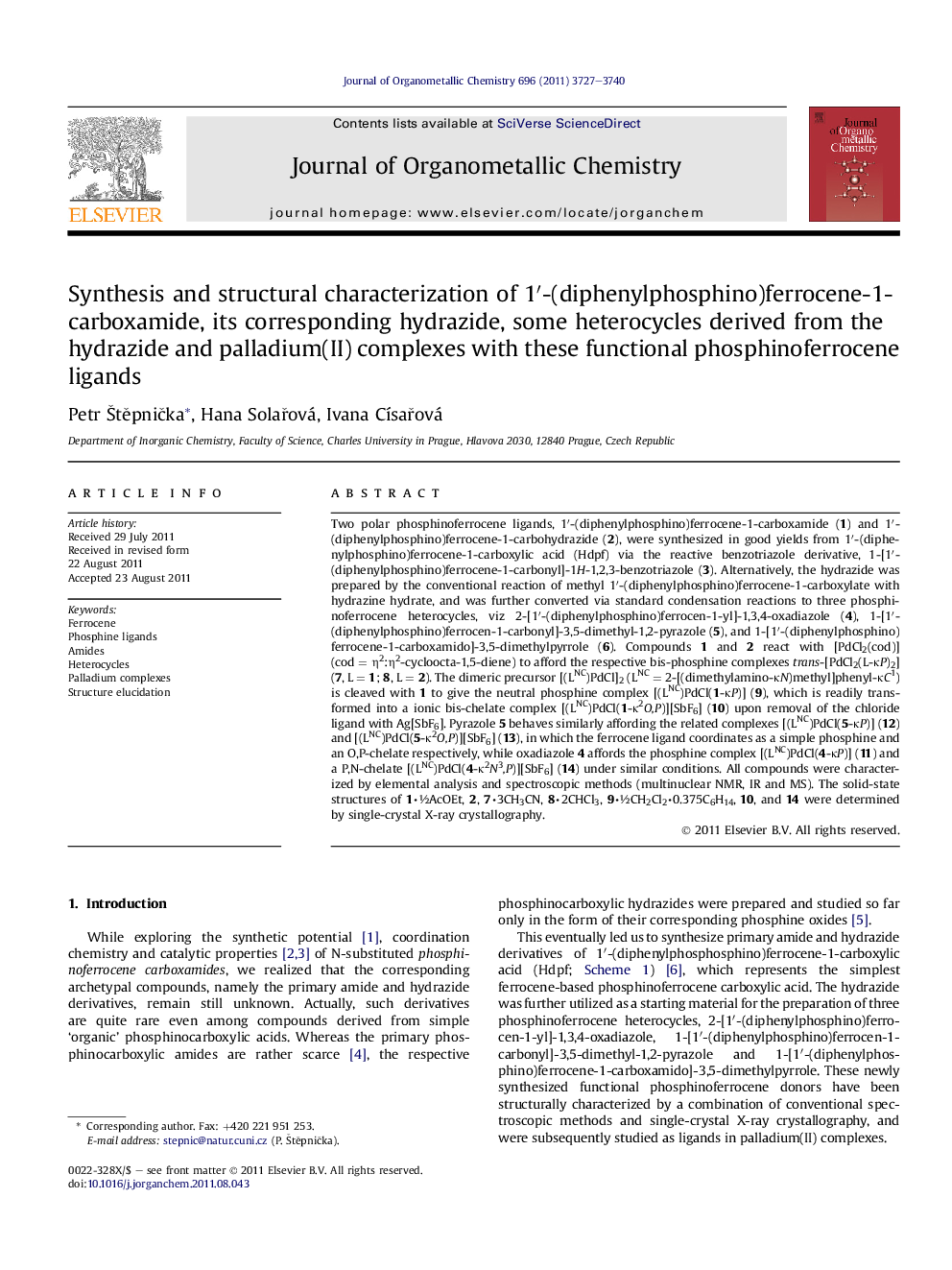| Article ID | Journal | Published Year | Pages | File Type |
|---|---|---|---|---|
| 1325112 | Journal of Organometallic Chemistry | 2011 | 14 Pages |
Two polar phosphinoferrocene ligands, 1′-(diphenylphosphino)ferrocene-1-carboxamide (1) and 1′-(diphenylphosphino)ferrocene-1-carbohydrazide (2), were synthesized in good yields from 1′-(diphenylphosphino)ferrocene-1-carboxylic acid (Hdpf) via the reactive benzotriazole derivative, 1-[1′-(diphenylphosphino)ferrocene-1-carbonyl]-1H-1,2,3-benzotriazole (3). Alternatively, the hydrazide was prepared by the conventional reaction of methyl 1′-(diphenylphosphino)ferrocene-1-carboxylate with hydrazine hydrate, and was further converted via standard condensation reactions to three phosphinoferrocene heterocycles, viz 2-[1′-(diphenylphosphino)ferrocen-1-yl]-1,3,4-oxadiazole (4), 1-[1′-(diphenylphosphino)ferrocen-1-carbonyl]-3,5-dimethyl-1,2-pyrazole (5), and 1-[1′-(diphenylphosphino)ferrocene-1-carboxamido]-3,5-dimethylpyrrole (6). Compounds 1 and 2 react with [PdCl2(cod)] (cod = η2:η2-cycloocta-1,5-diene) to afford the respective bis-phosphine complexes trans-[PdCl2(L-κP)2] (7, L = 1; 8, L = 2). The dimeric precursor [(LNC)PdCl]2 (LNC = 2-[(dimethylamino-κN)methyl]phenyl-κC1) is cleaved with 1 to give the neutral phosphine complex [(LNC)PdCl(1-κP)] (9), which is readily transformed into a ionic bis-chelate complex [(LNC)PdCl(1-κ2O,P)][SbF6] (10) upon removal of the chloride ligand with Ag[SbF6]. Pyrazole 5 behaves similarly affording the related complexes [(LNC)PdCl(5-κP)] (12) and [(LNC)PdCl(5-κ2O,P)][SbF6] (13), in which the ferrocene ligand coordinates as a simple phosphine and an O,P-chelate respectively, while oxadiazole 4 affords the phosphine complex [(LNC)PdCl(4-κP)] (11) and a P,N-chelate [(LNC)PdCl(4-κ2N3,P)][SbF6] (14) under similar conditions. All compounds were characterized by elemental analysis and spectroscopic methods (multinuclear NMR, IR and MS). The solid-state structures of 1⋅½AcOEt, 2, 7⋅3CH3CN, 8⋅2CHCl3, 9⋅½CH2Cl2⋅0.375C6H14, 10, and 14 were determined by single-crystal X-ray crystallography.
Graphical abstractA series of new phosphinoferrocene donors bearing polar amide and heterocyclic substituents in position 1′ of the ferrocene unit have been synthesized from Hdpf and tested as ligands in palladium(II) complexes.Figure optionsDownload full-size imageDownload as PowerPoint slideHighlights► Simple phosphinoferrocene amide and hydrazide were prepared and characterized. ► The hydrazide was used for the preparation of several phosphinoferrocene heterocycles. ► All phosphinoferrocene compounds were tested as ligands in palladium(II) complexes.
